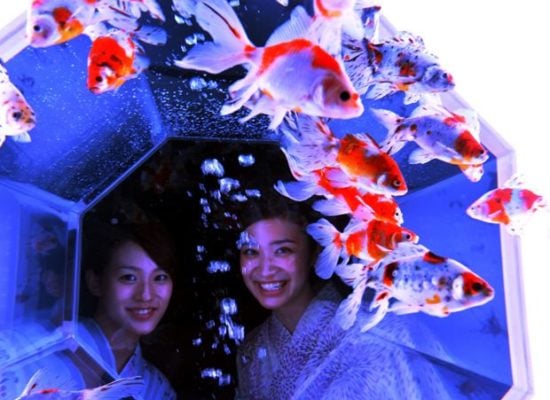What do you get when you mix contemporary art, traditional Japanese culture, and Tokyo nightlife? Hidetomo Kimura’s Art Aquarium, a hugely popular annual exhibition that draws crowds of stylish young people eager to sip colorful cocktails and admire exotic goldfish in uniquely-designed tanks while a DJ spins J-pop tunes. To date, the many iterations of the show have allegedly attracted over 300 million visitors.
Hidden away in the upper levels of the Nihombashi Mitsui Hall, the show is a welcome respite from the Tokyo heat, and a uniquely Japanese experience. Kimura, who serves as both artist (or “aquartist,” which is an amazing portmanteau) and producer, has created an otherworldly spectacle with his prismatic fish tanks and tactful deployment of colored light. “Beyond the technology that catches people’s heart, there lies natural beauty this earth has created,” he says in an introductory statement preceding the show.
Kingyo goldfish have a long and storied history in Japan, first arriving from China in 1502. Initially available only to the wealthy elite, kingyo became wildly popular during the Edo period that predated Tokyo (1603–1867). Over the years, the Japanese have carefully bred the ornamental fish to create exaggerated characteristics such as bulging eyes, wrinkled foreheads, and puffy cheeks. (There’s even a book on the practice, Kingyo: The Artistry of Japanese Goldfish.)
The exhibition features all sorts of bizarrely beautiful fish—about 5,000 in total and each one perfectly content and well-cared for, “living their happy hours,” if the intro text from Kimura is to be believed. The stage is set dramatically by the first set of tanks, called Bonborium, which are shaped to resemble traditional Japanese lanterns, and are illuminated in different shades of colored light. A sign encourages viewers to “please enjoy the collaboration of kingyo lighted with an abstracted air and the slowly changing light.”
Next, Kimura offers a series of elegantly spare circular tanks, filled to the brim to create a smooth liquid surface, offering an ideal view of the beautiful fish—unlike the majority of the show. The Reflectrium utilizes a series of concave and convex lenses to distort the image of the fish, while the angled surfaces of the Pardoxrium creates a mind-bending mirrored illusion. A sphere-shaped tank, the Earth Aquarium Japonism, surrounded by smaller round tanks projecting from the walls, resembles a giant fish-filled crystal ball, with water gently streaming down its surface.
The most popular piece in the show by far is the Byoburium II, an aquatic take on the Japanese folding screen. Its 12 tanks of kingyo (the previous edition of the work had only half as many) serve as a projection screen for a series of animated images illustrating the months of the year, accompanied by a musical soundtrack.
Although each piece in the installation has its own unique characteristics, artnet News couldn’t help but wonder what was being lost in translation. So much of the inspiration seemed to come from traditional practices deeply ingrained in Japanese culture, but utterly indecipherable to Westerners. Even without the full context, it was easy to be charmed by the beauty of the fish, their scales gleaming in the shifting light, and to appreciate the unique designs of the tanks, which capitalized on the effects of refraction and reflection.
artnet News admittedly understands very little Japanese, but the fashion-forward crowd (traditional kimonos were a popular choice for the ladies) seemed impressed with the kingyo display, taking lots of photos and frequently using the words sugoi and kawaii, or “cool” and “cute.” It may or may not be art, but on that front, we agree.
Check out this video of the fish in action:
